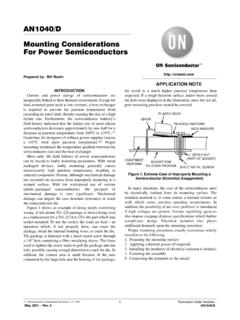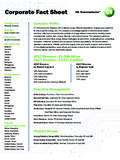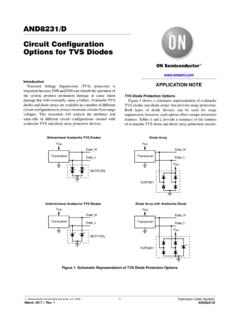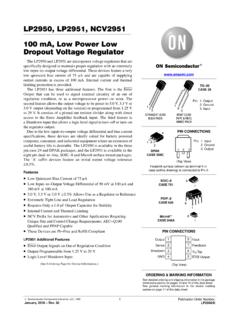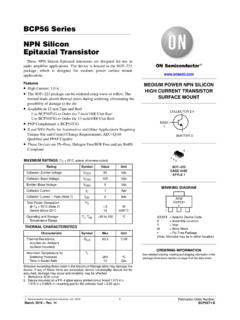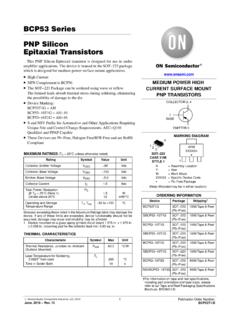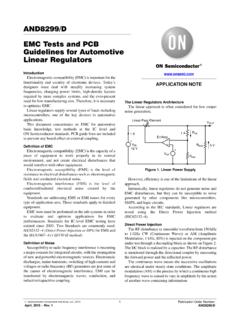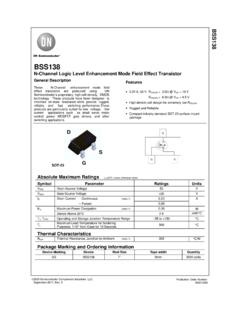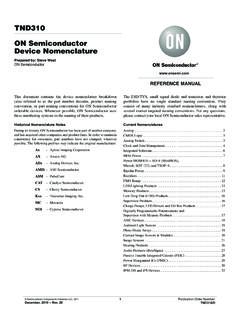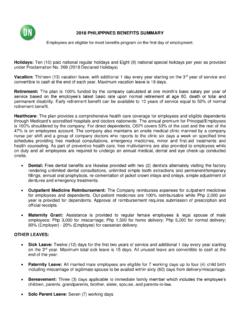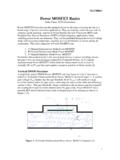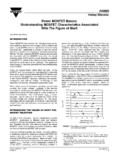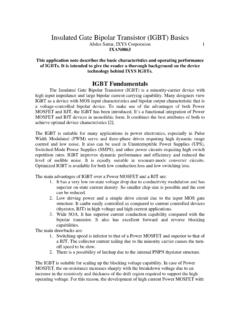Transcription of Is Now Part of - Semiconductor and Integrated …
1 To learn more about ON Semiconductor , please visit our website at Now part ofON Semiconductor and the ON Semiconductor logo are trademarks of Semiconductor Components Industries, LLC dba ON Semiconductor or its subsidiaries in the United States and/or other countries. ON Semiconductor owns the rights to a number of patents, trademarks, copyrights, trade secrets, and other intellectual property. A listing of ON Semiconductor s product/patent coverage may be accessed at ON Semiconductor reserves the right to make changes without further notice to any products herein. ON Semiconductor makes no warranty, representation or guarantee regarding the suitability of its products for any particular purpose, nor does ON Semiconductor assume any liability arising out of the application or use of any product or circuit, and specifically disclaims any and all liability, including without limitation special, consequential or incidental damages.
2 Buyer is responsible for its products and applications using ON Semiconductor products, including compliance with all laws, regulations and safety requirements or standards, regardless of any support or applications information provided by ON Semiconductor . Typical parameters which may be provided in ON Semiconductor data sheets and/or specifications can and do vary in different applications and actual performance may vary over time. All operating parameters, including Typicals must be validated for each customer application by customer s technical experts. ON Semiconductor does not convey any license under its patent rights nor the rights of others.
3 ON Semiconductor products are not designed, intended, or authorized for use as a critical component in life support systems or any FDA Class 3 medical devices or medical devices with a same or similar classification in a foreign jurisdiction or any devices intended for implantation in the human body. Should Buyer purchase or use ON Semiconductor products for any such unintended or unauthorized application, Buyer shall indemnify and hold ON Semiconductor and its officers, employees, subsidiaries, affiliates, and distributors harmless against all claims, costs, damages, and expenses, and reasonable attorney fees arising out of, directly or indirectly, any claim of personal injury or death associated with such unintended or unauthorized use, even if such claim alleges that ON Semiconductor was negligent regarding the design or manufacture of the part .
4 ON Semiconductor is an Equal Opportunity/Affirmative Action Employer. This literature is subject to all applicable copyright laws and is not for resale in any 2000 Fairchild Semiconductor Corporation Rev. 9/4/13 AN-9010 MOSFET basics Summary The Bipolar Power Transistor (BPT), as a switching device for power applications, had a few disadvantages. This led to the development of the power Metal Oxide Semiconductor Field Effect Transistor (MOSFET). The power MOSFET is used in applications such as Switched Mode Power Supplies (SMPS), computer peripherals, automotive, and motor control.
5 Continuous research has improved its characteristics for replacing the BJT. This application note is a general description of power mosfets and a presentation of some of Fairchild s product specifications. History The theory behind the Field Effect Transistor (FET) has been known since 1920~1930, which is 20 years before the bipolar junction transistor was invented. At that time, Lilienfeld of the USA suggested a transistor model having two metal contacts on each side with a metallic plate (aluminum) on top of the Semiconductor .
6 The electric field at the Semiconductor surface, formed by the voltage supplied at the metallic plate, enables the control of the current flow between the metal contacts. This was the initial concept of the FET. Due to lack of appropriate Semiconductor materials and immature technology, development was very slow. William Shockely introduced Junction Field Effect Transistors (JFETs) in 1952. Dacey and Ross improved on it in 1953. In JFETs, Lilienfeld s metallic field is replaced by a P-N junction, the metal contacts are called source and drain, and the field effect electrode is called a gate.
7 Research in small-signal mosfets continued without any significant improvements in power MOSFET design, until new products were introduced in the 1970s. In March of 1986, Fairchild formed with nine people and began research on power mosfets . 1990 s, Fairchild has developed a QFET devices using planar technology and low-voltage PowerTrench products using trench technology. AN-9010 APPLICATION NOTE 2000 Fairchild Semiconductor Corporation Rev. 9/4/13 2 1. FETS Junction Field Effect Transistors (JFETs) There are two types of JFETs: an N-channel type and a P-channel type.
8 They both control the drain-to-source current by the voltage supplied to the gate. As shown in Figure 1 (a) , if the bias is not supplied at the gate, the current flows from the drain to the source. When the bias is supplied at the gate, the depletion region begins to grow and reduces the current, as shown in Figure 1 (b). The reason for the wider depletion region of the drain, compared to the source depletion region, is that the reverse bias of the gate and the drain, VDG (=VGS+VDS), is higher than the bias between the gate and the source, VGS. (a) VGS (Gate-Source Voltage) is Not Supplied (b) VGS (Gate-Source Voltage) is Supplied Figure 1.
9 Structure of a JFET and its Operation Metal Oxide Semiconductor Field Effect Transistors ( mosfets ) The two types of mosfets are depletion type and enhancement type, and each has a N/P channel type. The depletion type is normally on and operates as a JFET (refer to Figure 2). The enhancement type is normally off, which means that the drain-to-source current increases as the voltage at the gate increases. No current flows when no voltage is supplied at the gate (refer to Figure 3). (a) VGS Gate-Source Voltage is Not Supplied (b) VGS (Gate-Source Voltage) is Supplied Figure 2.
10 Structure of a Depletion Type MOSFET and its Operation (a) VGS (Gate-Source Voltage) is Not Supplied (b) VGS (Gate-Source Voltage) is Supplied Figure 3. Structure of a Enhancement Type MOSFET and its Operation AN-9010 APPLICATION NOTE 2000 Fairchild Semiconductor Corporation Rev. 9/4/13 3 2. Structure of a MOSFET Lateral Channel Design The drain, gate, and source terminals are placed on the surface of a silicon wafer. This is suitable for integration, but not for obtaining high power ratings because the distance between source and drain must be large to obtain better voltage blocking capability.
